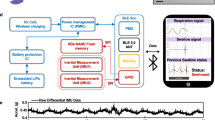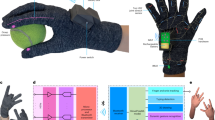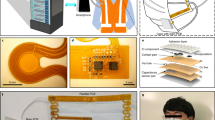Abstract
Keyboards and touchscreens are widely used to control electronic devices, but these can be difficult to operate for individuals with dexterity impairments or neurological conditions. Several assistive technologies, such as voice recognition and eye tracking, have been developed to provide alternate methods of control. However, these can have problems in terms of use and maintenance. Here we report a bite-controlled optoelectronic system that uses mechanoluminescence-powered distributed-optical-fibre sensors that are integrated into mouthguards. Phosphors that are sensitive to mechanical stimulus are arranged in an array of contact pads in a flexible mouthguard; by using unique patterns of occlusal contacts in lateral positions, various forms of mechanical deformation can be distinguished by the fibre sensors via ratiometric luminescence measurements. By combining the device with machine learning algorithms, it is possible to translate complex bite patterns into specific data inputs with an accuracy of 98%. We show that interactive mouthguards can be used to operate computers, smartphones and wheelchairs.
This is a preview of subscription content, access via your institution
Access options
Access Nature and 54 other Nature Portfolio journals
Get Nature+, our best-value online-access subscription
$29.99 / 30 days
cancel any time
Subscribe to this journal
Receive 12 digital issues and online access to articles
$119.00 per year
only $9.92 per issue
Buy this article
- Purchase on Springer Link
- Instant access to full article PDF
Prices may be subject to local taxes which are calculated during checkout





Similar content being viewed by others
Data availability
The data that support the plots within this paper and other findings of the study are available from the corresponding authors upon reasonable request.
Code availability
The code is available from the corresponding authors upon reasonable request.
References
Yu, X. et al. Skin-integrated wireless haptic interfaces for virtual and augmented reality. Nature 575, 473–479 (2019).
Zhou, Z. et al. Sign-to-speech translation using machine-learning-assisted stretchable sensor arrays. Nat. Electron. 3, 571–578 (2020).
Bouton, C. E. et al. Restoring cortical control of functional movement in a human with quadriplegia. Nature 533, 247–250 (2016).
Bai, H. D. et al. Stretchable distributed fiber-optic sensors. Science 370, 848–852 (2020).
Cao, W. J. et al. Voice controlled wheelchair integration rehabilitation training and posture transformation for people with lower limb motor dysfunction. Technol. Health Care 29, 609–614 (2021).
Pei, J. et al. Towards artificial general intelligence with hybrid Tianjic chip architecture. Nature 572, 106–111 (2019).
Jin, P., Zou, J., Zhou, T. & Ding, N. Eye activity tracks task-relevant structures during speech and auditory sequence perception. Nat. Commun. 9, 5374 (2018).
Oyama, A. et al. Novel method for rapid assessment of cognitive impairment using high-performance eye-tracking technology. Sci. Rep. 9, 12932 (2019).
Lee, H., Park, S. H., Yoo, J. H., Jung, S. H. & Huh, J. H. Face recognition at a distance for a stand-alone access control system. Sensors 20, s20030785 (2020).
Guo, H. Y. et al. A highly sensitive, self-powered triboelectric auditory sensor for social robotics and hearing aids. Sci. Robot. 3, eaat2516 (2018).
Nuyujukian, P. et al. Cortical control of a tablet computer by people with paralysis. PLoS ONE 13, e0204566 (2018).
Willett, F. R., Avansino, D. T., Hochberg, L. R., Henderson, J. M. & Shenoy, K. V. High-performance brain-to-text communication via handwriting. Nature 593, 249–254 (2021).
Kim, J. et al. Wearable salivary uric acid mouthguard biosensor with integrated wireless electronics. Biosens. Bioelectron. 74, 1061–1068 (2015).
Verma, T. P., Kumathalli, K. I., Jain, V. & Kumar, R. Bite force recording devices—a review. J. Clin. Diagn. Res. 11, ZE01–ZE05 (2017).
Kim, T. et al. Heterogeneous sensing in a multifunctional soft sensor for human-robot interfaces. Sci. Robot. 5, eabc6878 (2020).
Xu, P. A. et al. Optical lace for synthetic afferent neural networks. Sci. Robot. 4, eaaw6304 (2019).
Li, G. et al. Self-powered soft robot in the Mariana Trench. Nature 591, 66–71 (2021).
Guo, J., Zhou, B., Yang, C., Dai, Q. & Kong, L. Stretchable and temperature‐sensitive polymer optical fibers for wearable health monitoring. Adv. Funct. Mater. 29, 1902898 (2019).
Lindsey, N. J., Dawe, T. C. & Ajo-Franklin, J. B. Illuminating seafloor faults and ocean dynamics with dark fiber distributed acoustic sensing. Science 366, 1103–1107 (2019).
Butler, K. T., Davies, D. W., Cartwright, H., Isayev, O. & Walsh, A. Machine learning for molecular and materials science. Nature 559, 547–555 (2018).
Qian, X. et al. Printable skin-driven mechanoluminescence devices via nanodoped matrix modification. Adv. Mater. 30, 1800291 (2018).
Du, Y. et al. Mechanically excited multicolor luminescence in lanthanide ions. Adv. Mater. 31, 1807062 (2019).
Zhao, Y. et al. Multiresponsive emissions in luminescent ions doped quaternary piezophotonic materials for mechanical‐to‐optical energy conversion and sensing applications. Adv. Funct. Mater. 31, 2010265 (2021).
Wang, X. et al. Dynamic pressure mapping of personalized handwriting by a flexible sensor matrix based on the mechanoluminescence process. Adv. Mater. 27, 2324–2331 (2015).
Zhang, J. et al. Flexible and stretchable mechanoluminescent fiber and fabric. J. Mater. Chem. C 5, 8027–8032 (2017).
Pan, C. et al. High-resolution electroluminescent imaging of pressure distribution using a piezoelectric nanowire LED array. Nat. Photon. 7, 752–758 (2013).
Zhao, X. et al. Self-powered user-interactive electronic skin for programmable touch operation platform. Sci. Adv. 6, eaba4294 (2020).
Araromi, O. A. et al. Ultra-sensitive and resilient compliant strain gauges for soft machines. Nature 587, 219–224 (2020).
Leber, A. et al. Soft and stretchable liquid metal transmission lines as distributed probes of multimodal deformations. Nat. Electron. 3, 316–326 (2020).
Zhao, S. & Zhu, R. Electronic skin with multifunction sensors based on thermosensation. Adv. Mater. 29, 1606151 (2017).
Chen, B., Zhang, X. & Wang, F. Expanding the toolbox of inorganic mechanoluminescence materials. Acc. Mater. Res. 2, 364–373 (2021).
Chandra, V. K., Chandra, B. P. & Jha, P. Self-recovery of mechanoluminescence in ZnS:Cu and ZnS:Mn phosphors by trapping of drifting charge carriers. Appl. Phys. Lett. 103, 161113 (2013).
Moon Jeong, S., Song, S., Lee, S.-K. & Choi, B. Mechanically driven light-generator with high durability. Appl. Phys. Lett. 102, 051110 (2013).
Qasem, A., Xiong, P., Ma, Z., Peng, M. & Yang, Z. Recent advances in mechanoluminescence of doped zinc sulfides. Laser Photonics Rev. 15, 2100276 (2021).
Wang, F. et al. Mechanoluminescence enhancement of ZnS:Cu,Mn with piezotronic effect induced trap-depth reduction originated from PVDF ferroelectric film. Nano Energy 63, 103861 (2019).
Zhuang, Y. & Xie, R. J. Mechanoluminescence rebrightening the prospects of stress sensing: a review. Adv. Mater. 33, e2005925 (2021).
Martincek, I., Pudis, D. & Chalupova, M. Technology for the preparation of PDMS optical fibers and some fiber structures. IEEE Photon. Technol. Lett. 26, 1446–1449 (2014).
Missinne, J. et al. Stretchable optical waveguides. Opt. Express 22, 4168–4179 (2014).
Harnett, C. K., Zhao, H. C. & Shepherd, R. F. Stretchable optical fibers: threads for strain-sensitive textiles. Adv. Mater. Technol. 2, 1700087 (2017).
Leber, A., Cholst, B., Sandt, J., Vogel, N. & Kolle, M. Stretchable thermoplastic elastomer optical fibers for sensing of extreme deformations. Adv. Funct. Mater. 29, 1802629 (2019).
Acknowledgements
This work is supported by the Ministry of Education Singapore (grant R-143-000-B43-114); Agency for Science, Technology and Research (A*STAR) (grant A1983c0038); National Research Foundation, Prime Minister’s Office, Singapore (CRP award no. NRF-NRFI05-2019-003 and NRF-CRP19-2017-01); National Basic Research Program of China (973 Program, grant 2015CB932200); and National Key R&D Program of China (YS2018YFB110012). We thank Yongan Tang, Zhuang Liu and Yong Zuo for their technical assistance.
Author information
Authors and Affiliations
Contributions
X.L., L.Y. and B.H. conceived and designed the project. X.L., B.Z. and R.Z. supervised the project and led the collaboration efforts. L.Y. characterized the materials and conducted the numerical simulations. C.L. completed the electrical device fabrication. B.H., L.Y. and H.Z. performed the luminescence measurements and conducted the experimental validation. B.H. and L.Y. wrote the manuscript. X.L., B.Z. and R.Z. edited the manuscript. All the authors participated in the discussion and analysis of the manuscript.
Corresponding authors
Ethics declarations
Competing interests
The authors declare no competing interests.
Peer review
Peer review information
Nature Electronics thanks Lin Dong, Meidan Ye and the other, anonymous, reviewer(s) for their contribution to the peer review of this work.
Additional information
Publisher’s note Springer Nature remains neutral with regard to jurisdictional claims in published maps and institutional affiliations.
Supplementary information
Supplementary Information
Supplementary Figs. 1–13 and Tables 1 and 2.
Supplementary Video 1
Characteristic of mp-DOF.
Supplementary Video 2
Keyboard type.
Supplementary Video 3
Wheelchair control and playing the piano.
Rights and permissions
Springer Nature or its licensor holds exclusive rights to this article under a publishing agreement with the author(s) or other rightsholder(s); author self-archiving of the accepted manuscript version of this article is solely governed by the terms of such publishing agreement and applicable law.
About this article
Cite this article
Hou, B., Yi, L., Li, C. et al. An interactive mouthguard based on mechanoluminescence-powered optical fibre sensors for bite-controlled device operation. Nat Electron 5, 682–693 (2022). https://doi.org/10.1038/s41928-022-00841-8
Received:
Accepted:
Published:
Issue Date:
DOI: https://doi.org/10.1038/s41928-022-00841-8
This article is cited by
-
Isostructural doping for organic persistent mechanoluminescence
Nature Communications (2024)
-
Motion artefact management for soft bioelectronics
Nature Reviews Bioengineering (2024)
-
Dual-channel mechano-phosphorescence: a combined locking effect with twisted molecular structures and robust interactions
Light: Science & Applications (2024)
-
Body-conformable light-emitting materials and devices
Nature Photonics (2024)
-
Wrinkled and Fibrous Conductive Bandages with Tunable Mechanoelectrical Response Toward Wearable Strain Sensors
Advanced Fiber Materials (2024)



